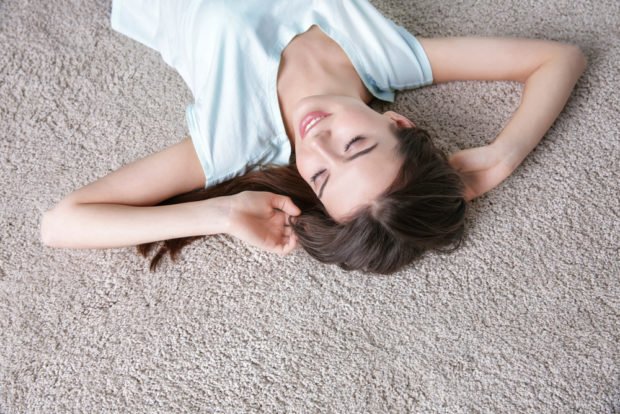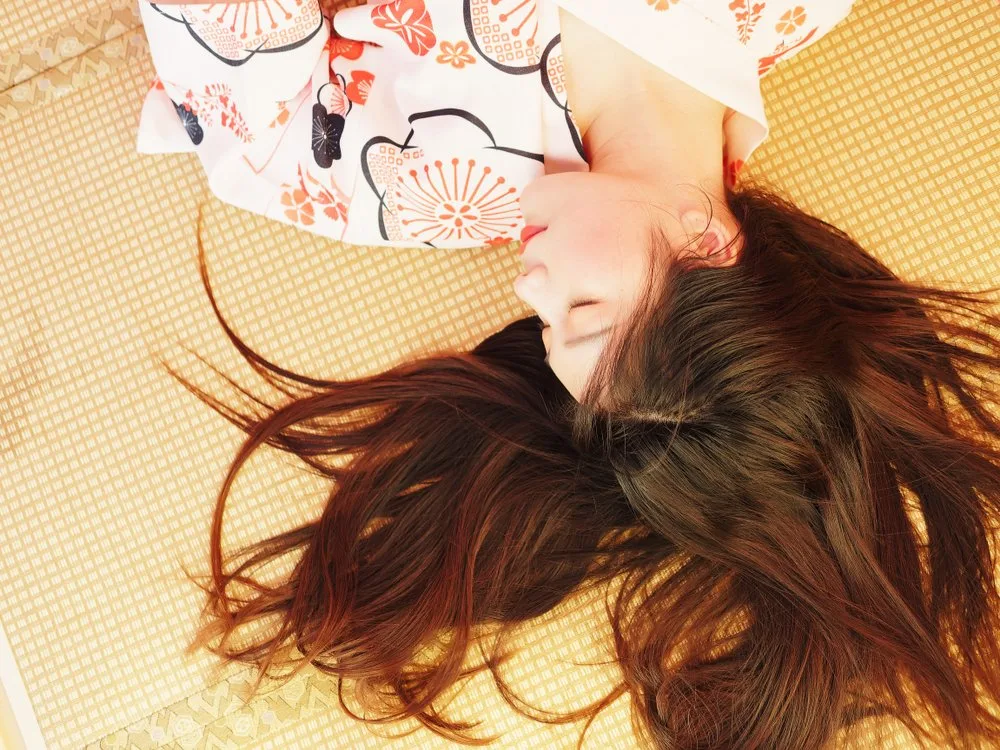Most people these days invest in finding the best, most comfortable mattress ever. Yet, simultaneously, a growing number of people are deciding to ditch the bed as we know it. In fact, they’re choosing to sleep on the floor. A glance at the Japanese will show you that the practice of sleeping on the floor is deeply rooted in ancestry. Furthermore, it also possesses quite a few health benefits.
So, who’s in the right here?
Should we all wave goodbye to beds as we know them, box springs, frames, and all?
Let’s find out together!
Tatami: A Word about Traditional Japanese Flooring
You can’t have traditional Japanese-style sleeping arrangements without the signature tatami flooring, so let’s start at the beginning.
Tatami is a floor mat made out of dried woven rush grass wrapped around and sewn into a rice straw core. Gentle, yet firm, they’ve been a part of the traditional Japanese homes for centuries now.
However, for the last 150 years or so, there’s been a steady decline in using traditional Japanese interiors. As you can imagine, tatami has given way to relatively “westernized” home designs. One of the main reasons being that tatami is far more challenging to clean than standard flooring.
That doesn’t mean that tatami is being forgotten, though.

It’s still an important part of heritage, culture and Japanese national identity. Moreover, it’s not uncommon to find one tatami-matted room in many homes. This is often done in an effort to not lose touch with their roots. Thus, a lot of families decided to keep this one Japanese-style room in their otherwise “westernized” homes.
And yes, you’ll find some Japanese people who still opt for sleeping on a futon placed on top of tatami mats. More on that later.
For now, I’d like you to remember that, unlike hardwood floors, tatami has a more natural give. This then makes sleeping on it very comfortable. Also, the futons we’re talking about here are nothing like those you may have had in your dorm room. Rather, they resemble thin mattresses that can be easily rolled up and stored in the closet when not in use.
Did you know that authentic tatami mats can have a soothing effect on you?
The grass used to make them lets out a natural fragrance that essentially works like aromatherapy. It’s particularly potent during rainy and humid days and it promotes relaxation and helps you sleep better. The mere smell of tatami can have nearly the same calming effect on you as taking a walk in the forest!
If you’re thinking of going fully Japanese-style and thinking of installing tatami mats, I figured I’d give you one more reason why that might be the best decision of your life. Everything from the look and feel to the actual smell of tatami makes it a welcome addition to any home, Japanese or otherwise.
Practicality or More: What Makes Sleeping Japanese-Style Awesome?
Unless you’ve visited Japan before, the idea of sleeping on the floor may sound strange. That said, it does have its perks.
Here are a few examples!
It’s Easier on the Wallet
There’s no arguing that beds can get pretty expensive. Regardless of whether or not you’re counting the basic stuff, like the pillows, bedding and blankets. Furthermore, the costs of buying a mattress, a frame, a headboard, and a box spring all add up.
Sleeping on the floor, however, requires a minimal initial investment – all you truly need is a quality futon, pillows, and a bedding set. That’s it – that’s all it takes to get your sleeping area ready for use.
It Promotes Space-Saving Living Arrangements
Sleeping Japanese-style can be the best decision you ever make because it saves a lot of space. Once the futon is folded up and stored away, your bedroom is no longer a bedroom. The area can then be utilized in plenty of different ways.
You see, Japanese houses are typically smaller than those you may see in Europe, let alone the United States. Rather than setting up a bedroom where the actual bed takes up the entire room, they opt to sleep on the floor. The “bed” is only there when you need it. Once the futon is put away during the day, they can use the room for other things.
It’s Easy To Create More Sleeping Space
Unless you happen to have a guest bedroom or two to spare, whenever you have friends sleeping over at your place, they’re doomed to sleep on the couch.
Well, not in Japan. Since a portion of available floor space and an extra futon (which, by the way, are relatively cheap and easy to store when folded) is all you need, it’s easy to create a sleeping space for any number of guests.
It Creates a Safer Environment
Although not all countries are affected by earthquakes to the same, often devastating degree, for Japanese people, earthquakes happen so often, that they’re pretty much regarded as a part of their daily life.The lack of bed frames, chairs, and tables do bring about a certain level of safety when it comes to sudden earthquakes. Why? There’s less furniture to block your way or get you in a possibly life-threatening situation. It may not be as apparent at first glance; however, sleeping directly on the floor can be a matter of safety, too.
Going Beyond Practicality: Are There Health Benefits of Sleeping on the Floor?
If you went on a camping trip before, you’re familiar with the idea of sleeping on the floor. The surroundings may be different, but the concept stays the same. No box springs, no bed frames, it’s just you, your sleeping bag, and the ground beneath you.
It wasn’t that bad, now, was it?
Plus, mattresses are relatively new concepts, anyway – our ancestors didn’t have them, and they still managed to sleep just fine. Nature had given us a way to rest well before comfy memory foam mattresses were ever a thing, and it’s called instinctive sleeping(1).
Say Goodbye to Back Pain
When it comes to the health benefits of sleeping on the floor, you’re certainly going to feel most of them in your back. Everything from pain to posture will start to improve slowly but surely. It’s one of the first effects most people will experience when they make the switch.

Eliminating back pain seems like a bold claim. After all, most mattresses available on the market promise to do the same. However, a lot of people do experience profound improvements in that aspect. This is because, without the “sinking” feel some beds provide, the relatively hard surface forces the body – back, neck, shoulders, and hips – in a straight line. As I’m sure you already know, proper spinal alignment is everything when it comes to treating (and preventing) aches and pains.
Natural Sleeping Posture
As a species, humans have been sleeping on the ground since day one. However, we’ve abandoned the concept in favor of plush, soft mattresses. We’ve forgotten that sleeping on the ground is the natural order of things.
We don’t give our bodies enough credit – they’re perfectly capable of handling sleeping on something other than a soft bed. And as many people who sleep on the floor will tell you, once all the extra cushioning is gone, the body has a chance to find its natural posture and alignment.
Again, our bodies adapt much faster than we think and will distribute the pressure in the best possible way, to ensure alignment and unobstructed blood flow throughout the body.
Rest and Energy Levels
Although most people pay very little attention to how they feel when they wake up, other than the occasional mental assessment of whether or not they’ll need an extra cup of coffee that day, and the reason behind it is that we’re taught to make the connection between how we feel after sleep and how much we sleep.
Well, sleeping on the floor may help you change that – by experience sleep quality at its best, and not having an overly comfortable bed to cloud your judgment, you’ll notice a significant improvement in your morning energy levels. You’ll feel more rested, and you’ll be ready to get up and start your day – simply because you won’t feel tempted to stay in bed for a little while longer.
What about Downsides?
There aren’t that many notable downsides to getting rid of bed frames and opting to sleep on the floor – if you’re a healthy individual, that is.
Although I consider this to be common sense, and I’m not sure it even counts as a legitimate downside, I’ll point it out anyway:
If there are medical reasons that require you to use a specialized mattress, let alone a hospital bed, sleeping on the floor should be the last thing on your mind. You need a specific mattress for a reason – don’t let that slip your mind.
Since that’s out of the way, let’s talk about the one actual downside that counts here – potential temperature-related issues. You’ve probably walked around your home barefoot, so you know how chilly areas without carpeting can get. Granted, it all depends on the type of flooring you have in your home – tile and concrete floors will be much colder than wood floors, for example, and not at all comfortable – so, that’s something you should factor in before you throw out your bed frame. Tatami is the ideal flooring option, but unless you live in a traditional Japanese home, chances are your house doesn’t have it installed.
Oh, and one more thing:
With nothing more than a futon as a buffer between you and the floor, you’re going to be much closer to all the dust and allergens that are hiding there, too. In short, if you fail to keep the area clean, you’ll create an unsanitary sleeping environment for yourself. There will be one that won’t look nearly as inviting and comfortable either. And although sleeping on the floor isn’t necessarily harmful, without regular cleaning and if there is poor indoor air quality, respiratory issues and allergies are a real possibility.
Final Thoughts
I don’t expect you to throw out your entire bed as soon as you’re done reading this. That wasn’t the point of this article, anyway.
Listen, sleeping on the floor might be something worth considering, whether right now or sometime in the future. If you do decide to make the transition, be sure to do it gradually.
Are you thinking of adding some tatami mats in your home? Did you get a chance to sleep on one, futon and all? Let us hear your experiences in the comments below!



![women [longevity live]](https://longevitylive.com/wp-content/uploads/2020/01/photo-of-women-walking-down-the-street-1116984-100x100.jpg)










